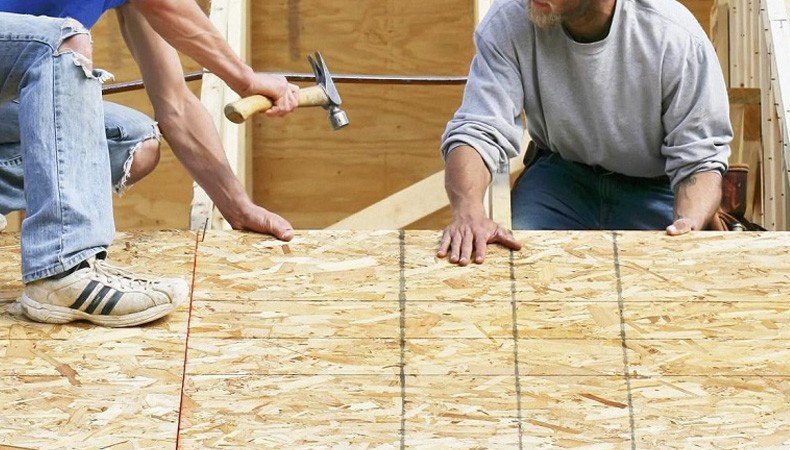Let us be completely honest roofing a house is no easy job. It can quickly turn into a full weekend project if not longer. This is especially true when the roof is non-traditional in style or size. However, even you can complete a straightforward roof installation if willing to put the resources and time into it. Just remember that roofing a house requires more than installing exterior shingles. It demands an entire team of components the pros refer to as a roof system and includes underlayment, metal flashing, and ridge cap. It is also necessary to have knowledge about the materials used and the way they waterproof your home by working together. Nonetheless, anyone that has the required tools, essential building materials, and pays close attention to the details is equipped to handle any roof repair or installation.
Building Materials Required
In this guide, we are assuming that the material being used will be asphalt or asphalt composition for the installation of the new roof. Almost 80% of residential homes use a traditional roofing system using these materials. When installed correctly, these tiles will have a lifespan of 20 to 25 years. To properly install a new traditional roof, the following building materials are needed:
- Asphalt or asphalt-composition shingles
- Felt paper (either No. 15 or No. 30)
- Roofing nails
- Roofing sealant
- Self-adhesive waterproof underlayment
- Drip edge
- Flashing for vents and valley
Tools and Equipment Required
Tools and equipment are other things to consider when starting your own roofing project. Installing a new roof is going to more than likely be a multi-day project. This makes it an excellent idea to acquire the tools and assemble them in advance to help speed up the project. In addition, you may want to think about if it is better for you to rent or buy certain tools.
For example, a roofing nailer can cost between $100 and $300. Whereas renting one can cost about $35 a day. Many hardware stores offer rentals of obscure tools such as these. If you know you may never need the tool again and only need it for a few days or weeks, then renting may be the way to go. If you decide to buy the tools needed, it is best to go for the highest quality that fits your budget. Higher quality makes the work easier and longer-lasting. Here is a list of the tools you will need:
- Work gloves
- Extension ladder
- Utility knife
- Chalk line
- Caulk gun (to add roofing sealant)
- Air hose or air compressor (to remove any debris)
- Roof harness (to prevent falling from the roof)
- Roofing stapler/nailer
- Hammer
- Tin snips
- Straight edge
- Circular saw
- Scaffolding
- Tarpaulin (to safeguard from falling materials)
Permits Required
Check with local building codes and determine whether permits are required in your area. Some municipalities require a certain number of shingles used or require particular materials. This ensures that no roofing materials are blown off during violent storms that can cause damage to surrounding homes. In addition, these codes are in place to guarantee that the community has a certain aesthetic continuity. Before starting, it is advisable to obtain the necessary permits, thus avoiding any costly penalties later. Once the materials and legalities are sorted out, it is time to get to the meat and potatoes. The construction of your new roof.
Roofing a House in 9 Steps
In this guide, we will detail nine uncomplicated steps of adding a new roof to a traditional building. Each step focuses on the essential act of blending each layer into a complete roof system that can withstand the natural elements.
#1: Raze the Roof
This may be the most apparent step in the whole process. You are going to want to remove the old roof. It is helpful to have a tarp laid down and a trash bin nearby. The removal will create quite a bit of debris and waste. Furthermore, you must remove strip the roof clean even if just intending to install a new underlayment or flashing. Also, be sure to pound down any nails as you remove the outer layers. You do not want exposed nails to damage shingles you are going to install.
#2: Underlayment Installation
If the old underlayment is still stuck on the roof in places keep in mind that it is alright. Just be sure that the roof surface is level and free of any debris that may impact the new underlayment. Some building codes will dictate what type and how much underlayment must be installed. As well as how much of the roof it covers. Check with the local building codes to be sure you are in compliance.
#3: Tar Paper the Underlayment
The next step is to cover the underlayment with tar paper. Number 15 or number 30 felt paper is required. Felt paper is also called tar paper and can be purchased at most home improvement stores. The felt has been treated with a special mixture of asphalt or asphalt composition to make it waterproof. Overlapping helps to improve the waterproofing qualities making it harder for the wind to blow rain between layers. Therefore, it is important to overlap every layer 2 inches or more as you work your way up the roof.
#4: Flash the Roof
Installing drip edge flashing along the eaves not only makes the roof aesthetically pleasing but is also functional. It helps to prevent the shingles from curling over the edges giving the roof a professional look. You should also flash the valleys of your roof and around any protruding structures such as vents or chimneys.
#5: Start the Starters
Starter shingles are the name for the first shingles laid on the roof. It is very important that orientation and placement are perfect as they provide the basis for the rest. Therefore, using a chalk line is a great idea to ensure every row will be in line with the starter.
#6: Installing the Shingles
Working from the placement of your starter, you can begin to install the shingles row by row. Most roofing experts will recommend a slight overhang on the drip edge of no more than ¼”. Also, be sure to follow the overlapping principle by making sure that each new layer overlaps the previous a bit.
#7: Nailing the Shingles
The standard number of nails per shingle is four. Although in very windy or gusty areas the experts will recommend six per shingle. Make sure to nail each new layer of shingles flush and straight on top of the starters. It is crucial to have perfectly linear rows and you should use chalk if having trouble doing so.
#8: Cap the Ridge
Almost there! Capping the ridge is one of the final steps, but can be one of the most critical. A superbly placed ridge cap is vital to the protection of your roof. The ridge is the area of the roof where the two slopping angles meet. Capping it properly adds another level of preservation to the roof ensuring it to last many years.
Remove Debris and Seal Up Exposed Nails
Finally, we have come to the last step. Inspect the roof and any nails that may be sticking out should be pounded in with a hammer. It is also a good idea to seal any exposed nails or pieces of flashing using a roofing sealant. Clean up any final debris and climb down to marvel at your work!
Conclusions
As you can see installing a new roof onto a home can be a big and labor-intensive job. However, with a bit of planning, some knowledge, and a fair amount of sweat, it can be done by anyone. Be sure to exercise caution and be as safe as possible. If the job is too difficult or out of your realm of comfort be sure to call a professional.

